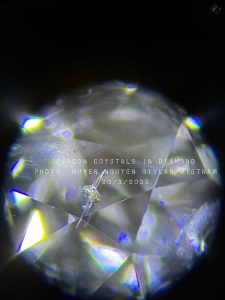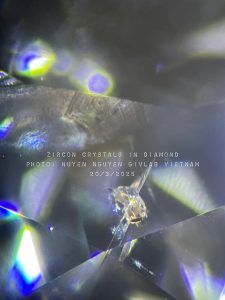Zircon Inclusions in Diamond: Evidence of Deep Geological Evolution.
Diamonds are not only rare gemstones but also valuable reservoirs of deep Earth geological information. The discovery of zircon (ZrSiO₄) inclusions in natural diamonds at the Givlab gemological laboratory, 159 Hang Bac, Hoan Kiem, Hanoi, provides crucial evidence of geochemical processes within the mantle.



Origin and Formation Conditions of Zircon in Diamond.
Zircon can appear in diamonds through two main mechanisms:
- Co-crystallization during diamond formation: When diamonds crystallize from a carbon-rich fluid in the deep mantle, zircon can co-crystallize or become trapped within the diamond structure.
- Incorporation during geological evolution: Zircon may form in mantle rocks before being encapsulated by diamonds during tectonic processes and deep material recycling.
Zircon is a highly stable mineral that forms at temperatures of 900–1400°C and pressures exceeding 5 GPa, often associated with mantle dynamics and supercontinent formation.
Geochemical Significance and Earth’s Evolution.
- U-Pb Dating: Zircon contains uranium (U), allowing precise age determination of diamonds, with some dating back as far as 3.5 billion years, reflecting deep Earth evolutionary history.
- Indicators of Ultra-High-Pressure Environments: The presence of zircon in diamonds confirms formation at depths greater than 150 km, providing insights into mantle material circulation.
- Evidence of Supercontinent Cycles and Mantle Tectonics: Zircon inclusions in diamonds can reveal information about continental collisions, crustal recycling, and subduction zone processes.
The study of zircon inclusions in diamonds not only aids in gemstone identification but also helps scientists decode Earth’s geological history from its earliest stages to the present day.
Article and Photography by: Huyen Nguyen, Gemologist, GIVLAB, VIETNAM.

 Tiếng Việt
Tiếng Việt